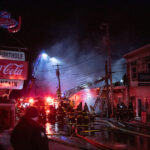A combination of predicted hot, dry weather, lightning and a widespread beetle infestation are spawning predictions of a summer wildfire season in Oregon worse than last year’s.
Dan O’Brien, spokesman for the Northwest Interagency Coordination Center in Portland, said forecasts call for more “monsoon” rains across the Southwest, and those storms often generate thunderstorms in Oregon.
Land managers worry that the beetle infestations in the Cascades could leave vast stands of dead trees, fueling wildfires.
An average wildfire season might burn 300,000 acres in Oregon and Washington, he said. “Last year was a very quiet year, and we still burned 200,000 acres.”
The Oregonian reports that mountain pine beetles have burrowed into many trees in the pine forests near Bend, turning the needles crimson.
The cyclic infestation has left dead and dying lodgepole pines across roughly 800,000 acres of the Cascade Range, up from perhaps 20,000 acres nine years ago, said Forest Service entomologist Andy Eglitis.
“You have the winter people and the summer people seeing it,” often from vantage points near the Mt. Bachelor Ski Area, Eglitis said. “It causes a tremendous amount of concern.”
“We are always nervous when we have this much dead fuel out there,” Eglitis said. “You’ve got a lot of people living right in the middle of that stuff.”
The beetles are centered south of Bend in the Fremont and Winema national forests. But other areas also are infested, and homes, golf courses and towns sit amid lodgepole forests.
Land managers say the situation is similar in Idaho.
Matt Filbert, a fuels expert on the Sawtooth National Recreation Area in Idaho, said lodgepole forests typically live 80 to 100 years and are wiped out by fires or bugs. “When it burns, it burns big,” he said.
Many of Idaho’s trees are Rocky Mountain lodgepole pine, whereas Oregon’s tend to be Sierra lodgepoles. Eglitis said the differences are scant. What Idaho is seeing “is not that different from what is going on” in central Oregon, he said.
Prescribed burning doesn’t work well to reduce wildfire danger in lodgepoles, Filbert said, because the fires too easily race out of control. Thinning isn’t a good option either, because the remaining trees, shorn of the protection of neighboring pines, can topple in a brisk wind.
Was this article valuable?
Here are more articles you may enjoy.


 FBI Involved After Two Florida Injury Lawyers Go Missing From Fishing Trip
FBI Involved After Two Florida Injury Lawyers Go Missing From Fishing Trip  Florida’s City National Bank Partnering With NSI to Offer Insurance Products
Florida’s City National Bank Partnering With NSI to Offer Insurance Products  Fire Damages Portland, Maine’s Historic Waterfront
Fire Damages Portland, Maine’s Historic Waterfront  South Texas Homebuilders Warn ICE Arrests Have Upended Industry
South Texas Homebuilders Warn ICE Arrests Have Upended Industry 

